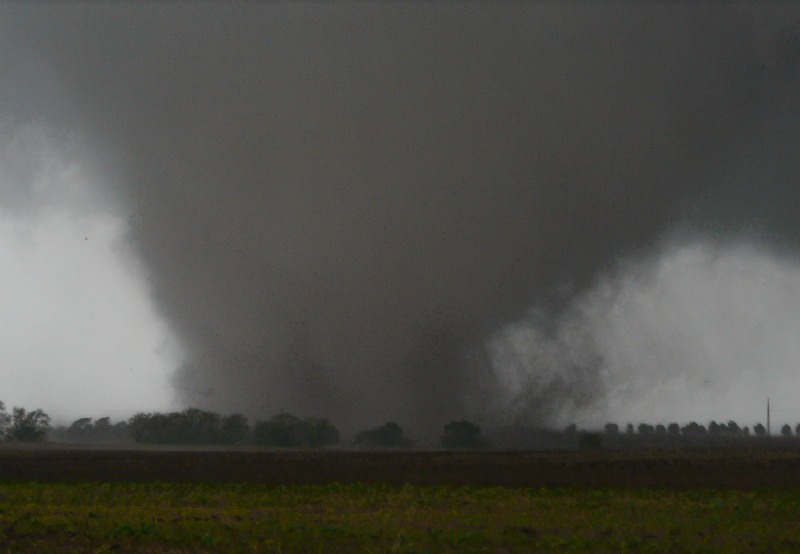Tornado Facts: Causes, Formation & Safety

Tornadoes are the most violent storms in nature. An average of 800 tornadoes are reported each year, resulting in 80 deaths and 1,500 injuries. Tornadoes are a worldwide phenomenon, touching down in every continent save Antarctica.
Dangerous funnels
Tornadoes form when different temperatures and humidity meet. In the United States, warm, wet winds travel north from the Gulf of Mexico in the spring and summer, where they meet cold, dry, south-moving Canadian fronts.
Generally, warm air rises, but when the two fronts meet, the cold air can trap the warm air beneath it. Because the warm air cannot move upward, it begins to rotate. As the sun heats the ground, more warm air continues to rise, until finally the mass is strong enough to push through the cold air barrier. The rising warm air pushes the cold air beneath it, creating a rotating column that can span up to 10 miles, while twisting at speeds exceeding 200 mph (322 km/h). [12 Twisted Tornado Facts]
The spinning air may remain unseen until it picks up enough dust and debris for its shape to be visible. Tornadoes can last for a minute or an hour, and they can tear a damage path up to 10 miles (16 kilometers) long.
Tornadoes forming over warm water are known as waterspouts, and are most common in southern states and along the Gulf Coast. Occasionally, waterspouts can move inward.
How safe are you?
The region lying between the Rocky and Appalachian Mountains — known informally as Tornado Alley — has the highest number of tornadoes in the United States each year; however, no place is safe. Tornadoes can occur anywhere in the United States, as well as in other countries. In fact, the United Kingdom reports the most tornadoes by land area.
In 1987, a tornado tore through Yellowstone National Park in Wyoming at elevations reaching up to 10,000 feet (3,048 meters), making it the highest altitude violent tornado in the United States. [Photo Gallery: Tornado Chasers]
Get the world’s most fascinating discoveries delivered straight to your inbox.
Tornado wind and debris cause most of the structural damage suffered, but nearly half of the injuries from such disasters occur after the tornado has left, during rescue work and cleanup. According to the Federal Emergency Management Agency, a third of these injuries come from stepping on nails. As such, it is important to remember to exercise caution even after the danger appears to have passed.
Tornadoes can occur at any time during the year, but they form most frequently in the spring and summer, depending upon your location. They are most likely to appear between 3 p.m. and 9 p.m., but again, they can occur at any time in the day or night.
Measuring a tornado
Tornados were once ranked by wind speed on the Fujita scale. It was upgraded to the Enhanced Fujita scale in 2007 and ranges from EF0 to EF5. An EF0 tornado may damage trees but not buildings, with winds ranging up to 85 mph (137 km/h). An EF5 tornado is devastating; winds exceed 200 mph (322 km/h), and buildings can be annihilated.
If a tornado hits
During strong thunderstorms, keep an ear on local weather alerts. FEMA encourages families to have a disaster plan in place for all contingencies, not only for tornadoes; this not only can keep you safe, but can allow for some peace of mind when families are separated. [Infographic: Tornado Season: What to Expect]
If your television or radio announces a tornado watch, this means that conditions are favorable for a tornado to form. Continue to listen for further updates. If a tornado warning is announced, it means a tornado has been sighted or indicated by radar. Move to a safe place immediately.
If a tornado strikes and you are inside a sturdy building, go to the lowest floor, such as the basement or storm cellar. If the building has no rooms beneath the ground, get to the lowest level possible and find an interior room, putting as many walls as possible between you and the tornado. Don't bother opening windows to equalize pressure; this will accomplish nothing except to allow more debris inside.
If you are in a mobile home or trailer, leave immediately. Find the lowest floor of a sturdy shelter, or a ditch or depression. Lie down flat and cover your head. Do not seek refuge under an overpass or bridge.
Never try to outrun a tornado. Instead, find a safe place to ride it out. Watch for flying debris, which causes the most fatalities and injuries while the tornado is in process.
Remember that almost half of tornado-related injuries occur after the tornado has ended. Be careful when entering buildings that have been damaged. Wear sturdy shoes and appropriate clothes to avoid scrapes. Monitor your radio for emergency information. Do not touched downed power lines or anything in contact with such lines. Watch (and smell) for gas line breaks.
Additional resources

Nola Taylor Tillman is a contributing writer for Live Science and Space.com. She loves all things space and astronomy-related, and enjoys the opportunity to learn more. She has a Bachelor’s degree in English and Astrophysics from Agnes Scott college and served as an intern at Sky & Telescope magazine. In her free time, she homeschools her four children.


